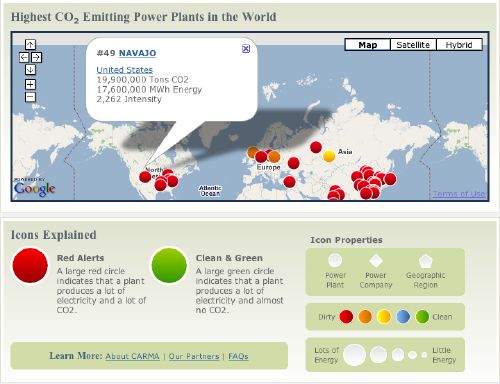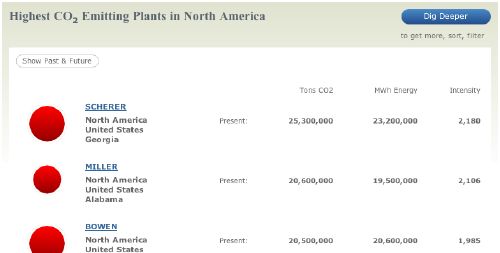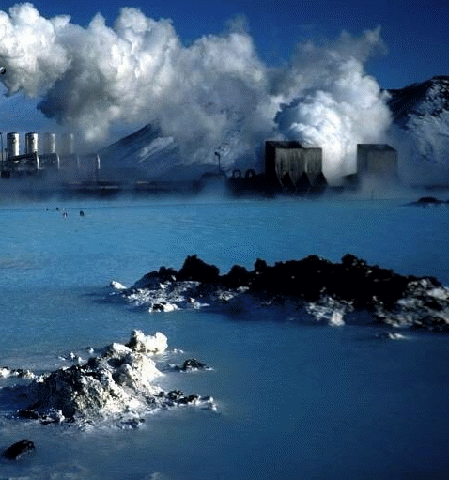Archive for the 'Environment' Category
ITAIPU: 63.3 GWh and zero emissions
A few days ago the link for Carbon Monitoring for Action (CARMA) was forwarded along to us. This is a mashup of the global electric power plant database on a map with visual representation of the size of the plant, intensity, and carbon contribution plotted on the map, globally, by continent, by country, by region/state, etc. Take a look at a screen shot below:

As you can see, the top 50 carbon emitters are plotted at a global level and #49 Navajo Power Plant is selected showing it produces 17.6 GWh of power along with 19.9 M tons of CO2 emissions per year. One of the more interesting things they track is intensity, or pounds of CO2 emitted per megawatt-hour of electricity produced.
The data in CARMA are compiled from numerous sources. Emissions data for thousands of power plants in the U.S., Canada, the EU, and India come from official reports. Other data are derived from information provided by power sector analysts, the International Energy Agency, the U.S. Department of Energy, the Environmental Protection Agency, and a host of geographic databases. So while it might not be 100% accurate, it’s credible and trackable and certainly better than what existed before.

The aggregations and zooming are very useful and it enables a researcher to determine not only the largest contributors to CO2 emissions, but also the most intense (or least efficient) as well as the lowest producers and most efficient power plants. One thing that may be surprising to people is that the largest electric power plants on the planet are also among the lowest CO2 emitters – gravity hyrdo-generation facilities. For instance, the largest plant on the planet is ITAIPU in Brazil, an 8 GW hydo facility producing over 63 GWh of power per year and zero CO2. In fact, of the 15 largest power plants globally (4 GW and over) – ten are zero CO2 emission.
If you’re interested in knowing more about power plants, their emissions, and impact, we encourage you to visit CARMA. Comments are off for this post
NOAA’s Carbon Tracker
In February of this year, the National Oceanic & Atmospheric Administration (NOAA) released a handy tool called Carbon Tracker. It is a visualization mechanism to see net carbon exchange over time using the mole system. You can see an example of the data, fossil emissions flux on the map below.
![]()
An interesting and handy tool to have at our disposal.
Photo of the day: Iceland’s Blue Lagoon

Iceland’s Svartsengi Power Plant produces 46MW electricity and 150MW thermal, then ejects clean water at 40C (104F) into this lagoon which is widely photographed and somewhat other worldly.
Carbon Sequestration of Coal Emissions

Much has been made of this technology for extracting the carbon dioxide from the emissions of coal fired electricity generation plants. The basic premise is that the waste gas is circulated through chilled ammonia which “captures” the carbon dioxide which is then pressurized and stored for reuse. The French power company Alstom is the inventor of this process which it claims is less expensive and feasible at utility scale.
Alstom and American Electric Power have agreed to collaborate on a 30MW proof-of-concept that will capture flue gas from AEP’s 1,300MW Mountaineer Plant located near New Haven, West Virginia. The PoC should be complete by late 2008. After the results are evaluated, AEP and Alstom may proceed to two other projects at utility scale with a 200MW capture facility on a 450MW AEP plant in Oklahoma.
Ideas for what to do with all the excess carbon dioxide include using it as a pressurization agent in enhanced oil recovery and storing the gas in stable salt domes (like present natural gas and strategic petroleum reserve facilities.) Other approaches are to use and enhance natural carbon processing ecosystems like plant mass and the ocean to reduce carbon dioxide levels.
As a matter of practicality, these are reasonable steps to take given that 50% of the US electrical power is created by burning coal and reducing the impact of that activity is a very good thing. But, it’s not sufficient, it needs to happen in concert with conservation as well as increasing the non-fossil fuel generation of electricity. As carbon sequestration becomes mandatory, that should help push the price of coal burning generation facilities to levels where renewable generation technologies are more cost effective. That’s just the catalyst needed to start vast change in the way we generate our electric power.
Coal backlash
With the announced acquisition of TXU earlier this week, Fortune magazine has published a story analyzing the future of coal.
Coal fired electric generation accounts for 48.8% of US electricity production. Of the fossil fuel choices, coal is the least expensive and most plentiful of fuels, costing just $1.67 per million BTUs, though the price is up from $1.20 per million BTUs in the year 2000. To bring the BTUs measurement home, 1,000,000 BTUs is equivalent to around 293 kilowatt hours, enough to power a small home in the US for a month. Experts claim there is a coal reserve in the US of around 1.3 million square kilometers (~500,000 square miles) that should last at current burn rates for around 250 years. At present, there are some 150 new coal fired plants in planning through construction phases in the US.
Every 1,000,000 watt/hours of power produced by coal results in 1,000 kg (2,200 lbs) of carbon dioxide and 15 kgs of sulphur and nitrogen oxides into the atmosphere. Coal mining happens in one of two ways, shaft mining and strip mining. Shaft mining is just what it sounds like, a shaft is sunk into the earth at some angle and the coal vein is followed underground with the coal being transported out of the mine for processing. Strip mining works for shallow veins where the non-coal material (overburden) is removed to access the coal vein which is removed and processed, and then the overburden is replaced and the land is reclaimed.
New research is underway to make coal cleaner and less damaging to the atmosphere including gassification and carbon sequestration technologies. Gassification is happening to some extent now and carbon sequestration may or may not work – the idea of capturing the carbon post burn and injecting it into the earth for storage sounds a little farfetched until one thinks about how natural gas is stored. There are several large salt domes that have been hollowed out by pumping in water to dissolve the salt then the resulting brine is pumped out leaving a chamber. Natural gas is then injected and stored in these reserviors. I don’t know if that’s exactly what researchers have in mind for carbon dioxide, but there is an existence proof of some sort.
These facts are important when considering the future of coal. Environmental objection is but one variable in the coal equation, and perhaps the least important when considering how to positively impact climate change. Another variable is cost, the most important and most influential variable. I believe cost is the key. Until and unless coal generated electricity becomes more expensive to produce other energy sources will not be sought with the vigor that is required to make a large impact.
The good news is, we can already see the cost factor coming into play. The TXU plants on the docket are slated to cost on the order of $1B a piece, or about $1M per megawatt of generation capability. Natural gas costs $0.75M per megawatt. Wind costs $1M per megawatt, but it’s not baseload power due to the fickle nature of wind. Solar is still a couple of technology generations away costing around $8M megawatt, it also suffers from capacity factor, it’s not generating power at night. Geothermal power is baseload, but with exploration costs included, it comes to $2.5M per megawatt. Geothermal exclusive of exploration is in the $1M per megawatt range. Coal gassification plants come in at around $2.5M per megawatt now and who knows what carbon sequestration will add in terms of cost. As you can see, coal plant construction prices are starting to encroach on renewable plant cost territory.
Operations costs are also creeping higher. The more stringent the emissions regulation, the more expensive it becomes to operate a coal fired plant. If we add in the cost of fuel over the 40 year lifetime of a plant, all of the sudden baseload renewable generation like geothermal looks pretty darned attractive.
That brings us to the most important variable, emissions regulation (which will be the largest single driver of coal electricity production cost.) A policy the new Congress could take on is to mandate new coal plants to have emissions no greater than a geothermal plant (I’ll accept 1980’s vintage Geysers plants as the benchmark even though new binary plants in a closed system would be better.) This would serve notice that investment must go into clean electricity generation and would have lasting impact over the next 20 years on climate change.
One thing is certain, market forces alone are not enough to tip the investment from coal to other clean technologies. The market needs a push in the form of strict emissions control which will cause the price of coal generation to rise sufficiently to cause alternate behaviors. Now is the time.
If you liked this entry, Digg It!
Technorati Tags: Energy | Coal | Emissions








